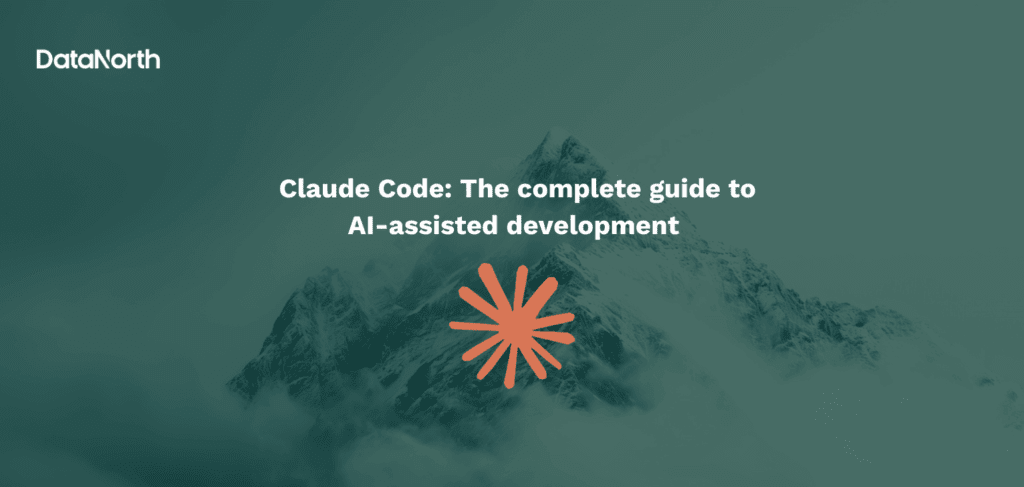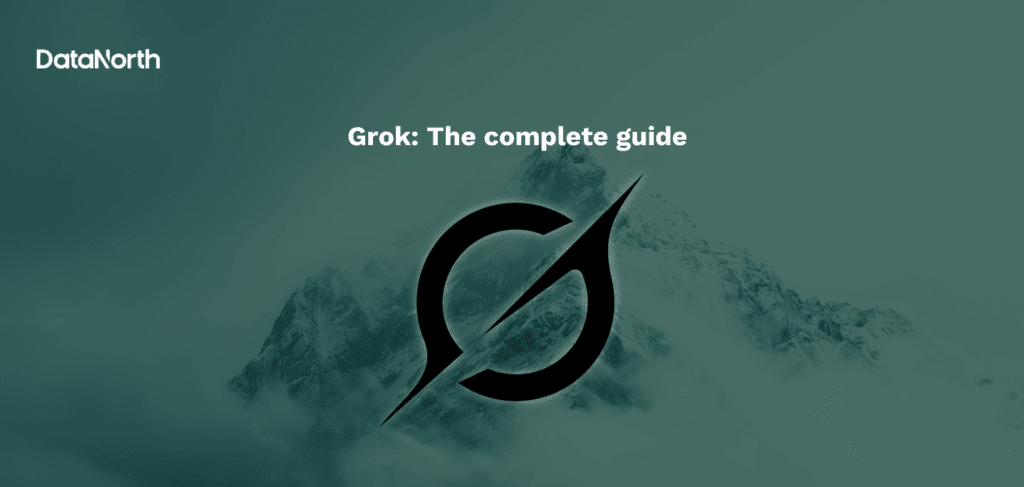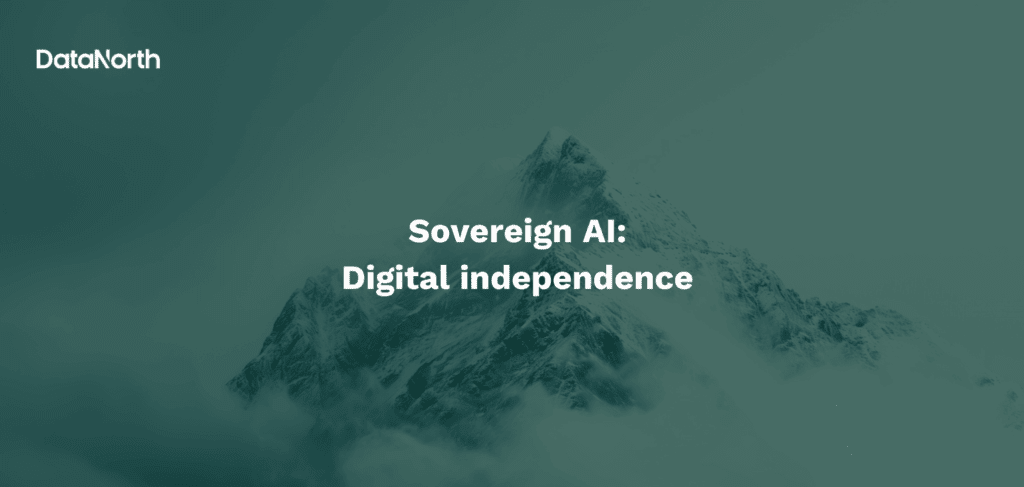ChatGPT, the buzzword that’s gone from tech curiosity to business essential.
When we first published this article, ChatGPT had just started turning heads. Fast forward to today, and it’s no longer just a fascinating piece of AI; it’s become a foundational tool for innovation, automation, and customer engagement across industries.
If you’re a business owner or executive, chances are you’re no longer just hearing about ChatGPT, you might already be experimenting with it or wondering how to implement it more strategically. The rapid evolution of the technology, especially with the release of GPT-4o, has opened up new possibilities and new questions. How can it create value for your organization? What are the risks? And where should you start?
In this updated guide, we revisit what ChatGPT is, explore what’s new in 2025, and provide practical insights into how it can drive efficiency, spark creativity, and support smarter decision-making in your business.
So let’s dive back in, because if you thought ChatGPT was a big deal in 2023, wait until you see what it can do now.
What is ChatGPT?
Developed by OpenAI, ChatGPT is a sophisticated language model capable of understanding and generating human-like text. The latest iteration, GPT-4o, introduced in 2025, offers enhanced reasoning, real-time web browsing, image generation, and data analysis capabilities.
ChatGPT is available in various plans to cater to different user needs:
- Free Plan: $0 a month
- Access to GPT-4o mini
- Real-time data from the web
- Limited access to GPT-4o, o4-mini and deep research
- Use custom GPTs
- *Limits on messaging, file uploads, data analysis, and image generation
- Plus Plan $20 a month
- Enhanced access
- Extended usage limits
- Full access to GPT-4o, o4-mini and deep research
- Additional tools
- Pro Plan $200 a month
- Unlimited access to all reasoning models
- Access to OpenAI o1 pro mode
- Extended access to deep research & Sora.
- Access to a research preview of Operator (AI Agent)
- Team Plan $25 a month per seat
Designed for collaborative teams with shared workspaces. Can be personalized by connecting internal knowledge from your organization’s Google Drive. - Enterprise Plan $60 a month per seat
- Offers enterprise-grade security
- Unlimited high-speed GPT-4 access
- Advanced data analysis capabilities
- More ChatGPT security and privacy measures are being taken to protect your data.
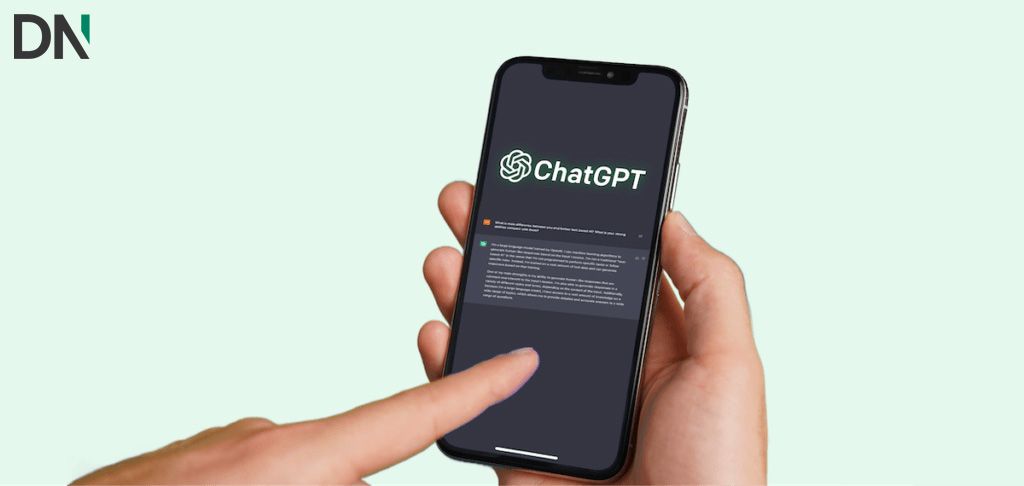
How does ChatGPT work?
On the face of it, ChatGPT’s technology may seem simple. It takes your requests, questions, or prompts and quickly answers them. As you would imagine, the technology to do this is a lot more complicated.
The model was trained using a large dataset of text from various sources including books, web texts, Wikipedia, articles, and other pieces of text from the internet. To be precise, it was trained with a whopping 570GB of data, containing 300 billion words. This extensive training allows ChatGPT to understand and respond to a wide range of prompts and questions.
As a language model, ChatGPT works on probability, able to guess what the next word in a sentence should be. The model went through a supervised testing stage, where it was fed with inputs (e.g. what is the color of grass?) and correct outputs (green) to help it build its knowledge. This process, known as data annotation, was repeated endlessly to ensure the model’s accuracy.
The model also went through a second similar stage, where multiple answers were offered and ranked by a member of the team. This helped the model to learn from comparisons and further improve its understanding of prompts and questions. This approach of supervised testing and ongoing learning sets ChatGPT apart from other language models and makes it the ultimate know-it-all.
The limitations of ChatGPT
While ChatGPT has made remarkable progress, with GPT-4o offering multimodal capabilities, improved speed, and broader context awareness, it’s still not without its shortcomings. As powerful as the tool is, it’s important to be aware of its boundaries to use it responsibly and effectively. Here are the most important limitations to keep in mind:
Not always up-to-date
Although the newest versions of ChatGPT can now browse the web (depending on your plan), this isn’t always real-time or universally available. In many cases, the model still relies on static knowledge up to a specific training cutoff. That means it may miss out on breaking news, recent market changes, or newly published research unless explicitly prompted to retrieve that information.
Wrong or overconfident answers
Even with advancements, OpenAI itself notes: “ChatGPT can make mistakes. Check important info.”. These mistakes are often referred to as “AI hallucinations”, confidently stated inaccuracies that could mislead decision-making if not caught and reviewed by a human expert.
Inherited bias from training data
ChatGPT is trained on massive internet datasets, which means it can sometimes reflect the biases, stereotypes, or assumptions present in those sources. While OpenAI has made strides in reducing bias, the issue hasn’t been entirely eliminated, so sensitive use cases should be handled with care.
Lacks emotional intelligence
ChatGPT can mimic empathy or tone, but it doesn’t feel emotions. It doesn’t truly understand user sentiment or emotional nuance, which means it can misfire in emotionally charged or customer service situations if not properly guided.
Limited creativity
While ChatGPT can generate ideas, draft stories, or brainstorm slogans, its creativity is derivative. It mixes and remixes patterns it has seen in training data, but it’s not a substitute for human originality, especially in brand-defining content.
Usage caps and availability (plan dependent)
Access to features like GPT-4o or real-time browsing may vary by plan. For free or lower-tier plans, users might face message caps, slower performance during peak times, or limited access to premium features.

Even though ChatGPT still has significant limitations, it has demonstrated suitability for many meaningful use cases and has stirred excitement in the business community. Let’s have a look at the main reasons why.
The opportunities for businesses
ChatGPT provides a vast array of opportunities for companies that harness its capabilities effectively. By automating repetitive tasks and providing more engaging interactions with users, chat-based AI can augment the way humans work.
Here are a few ways companies can make use of ChatGPT’s capabilities:
- Customer support
- Data Analysis
- Content creation
- Brainstorming
- Writing code and debugging
- Automating sales
- Streamlining processes
- Translating
- Onboarding
Customer support
Deploy ChatGPT-powered chatbots to handle customer inquiries, provide instant support, and improve response times, leading to increased customer satisfaction. ChatGPT can also assist with providing personalized instructions and assistance to customers after they have bought a product. This can be of great worth for customer service teams when formulating instructions for using a product, troubleshooting guides, and FAQs.
Data analysis
ChatGPT can assist with gathering and organizing data from various sources, providing quick access to relevant information. As a result, you can use ChatGPT to perform your own market research by analyzing and summarizing large amounts of data from surveys and reports. This can save you the costs of hiring a market research company. Simply use ChatGPT’s data analysis capabilities to interpret complex datasets, generate reports, and extract actionable insights for informed decision-making .
Content creation
With its natural language generation capabilities, ChatGPT can help create content that resonates with your target audience. Although it lacks some creativity, a human can provide the creative spark and direction, while ChatGPT can handle the heavy lifting of generating a high volume of content. Together, the combination of human creativity and ChatGPT’s ability to generate text can make for an efficient and effective content-creation process. Utilize ChatGPT to generate blog posts, social media content, product descriptions, and marketing copy, streamlining content production workflows.
Brainstorming
ChatGPT can assist with generating ideas, by providing suggestions and inspiration. For example, a product development team can use it to generate a list of potential features for a new product, based on trends and customer feedback.
Writing code and debugging
ChatGPT can assist with writing code, by generating code snippets and providing suggestions for improving the code. In doing so, developers can use it to generate code for specific tasks, such as data validation or error handling, and to identify and fix errors in existing code. This will save them a lot of time, which they can then spend on more meaningful and complex tasks.
Automating sales
ChatGPT can assist with automating repetitive tasks in the sales process, such as sending follow-up emails or scheduling meetings. Your sales team, for example, can use it to generate personalized emails to prospects in a fraction of the time it would take to do it manually.
Streamlining processes
ChatGPT can assist with automating various tasks, such as data entry, to improve efficiency. Besides an increase in efficiency, automating data entry also reduces errors from employees doing repetitive tasks where fatigue sets in after a while . This will not only save you a lot of time and money, but it will shorten turnaround times and increase customer satisfaction as well.
Translating
ChatGPT can assist with translating text, providing accurate translations in a matter of seconds. Do you make extensive use of translation services at the moment? Chances are, you won’t have to do so much anymore! Just use ChatGPT to generate a first draft and have it reviewed by a translator.
Onboarding (Customers & Employees)
ChatGPT can help guide new customers through the onboarding process by providing assistance and answering any questions they may have. For example, you can use it to generate customized onboarding emails, welcome messages, and FAQs for new customers. This process can also be used for the onboarding of new employees, freeing up time for HR to focus on the more important things.
In summary, ChatGPT can be useful for any situation where natural-sounding text needs to be generated based on input data. Companies that take advantage of its capabilities can improve their efficiency, enhance customer engagement, and ultimately increase their bottom line. To get more inspiration about how to use ChatGPT in your business, read our blog about ChatGPT use cases for businesses and read our blog about What is Prompt Engineering? to learn more about how to prompt ChatGPT.
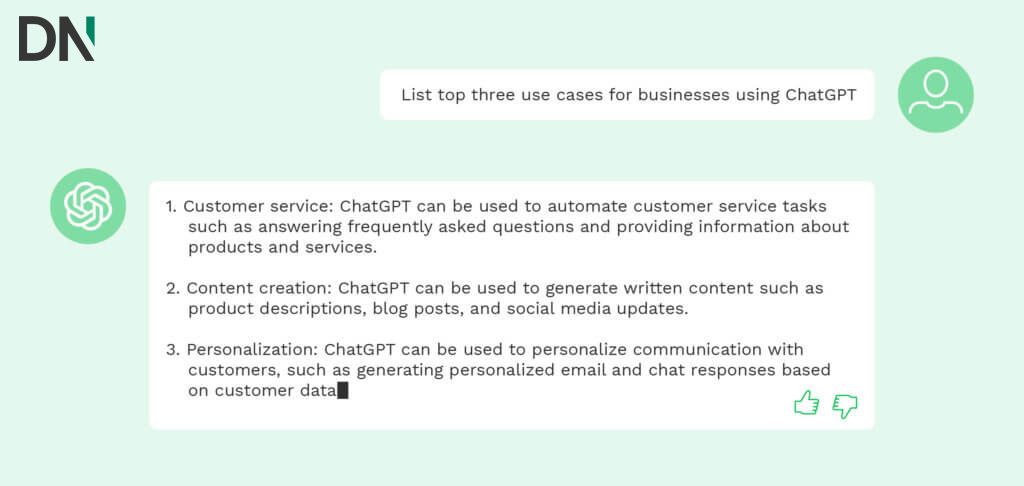
Should you now rush into things and start using ChatGPT in every single operation? We don’t think so, at least for now. It is crucial for you to weigh the potential benefits and risks of ChatGPT, and make informed decisions about its implementation in your operations. That’s why we’ll cover the potential threats next.
The potential threats to businesses
The potential of ChatGPT to drive innovation and improve efficiency for businesses across various industries is undeniable. However, as with any emerging technology, it’s crucial to be aware of its potential threats to your company. Below, you’ll find the most important ones:
- Businesses become obsolete
- Financial fraud
- Lack of accountability
- Privacy risks
Businesses become obsolete
One of the biggest concerns about chat-based AI is that it has the potential to make certain businesses redundant or obsolete. For example, translation or content creation services may be affected by the rise of ChatGPT. As it can produce accurate translations and high-quality content in a fraction of the time it would take a human to do so, companies providing such services may go out of business. In this threat there is also opportunity for those who adapt to the new way of work. As history has shown time and again, those who stand still get left behind.
Fraud
ChatGPT can also be used by cybercriminals to commit all kinds of fraud, ranging from business identity theft to invoice fraud. For example, criminals could manipulate people into disclosing sensitive information using the chatbot, and then use that information for fraudulent purposes or targeted phishing attacks. This can lead to reputational damage, financial losses, and legal liabilities for businesses.
Lack of accountability
ChatGPT, being an AI model, doesn’t have the ability to take responsibility for its actions. This can lead to problems when something goes wrong, such as providing incorrect or inappropriate information. It can be difficult for businesses to determine who is liable in these situations and how to mitigate the damage.
Privacy risks
ChatGPT is trained on a large dataset of text from the internet, which may include personal information. This can lead to privacy risks, such as the unauthorized disclosure of personal information or the creation of targeted advertising. Businesses need to be aware of these risks and take appropriate measures to protect personal information.
Want to learn more about how to protect your privacy with ChatGPT? Read our blog on ChatGPT & Data Privacy.
That’s quite a lot to digest, right? The bottom line is that you need to be aware of the potential threats of ChatGPT. By understanding them, you can make better-informed decisions about how to use the technology effectively and safely.
So far so good, but you may still wonder where to start. No worries, we will discuss the first steps to take next.
The first steps for executives
If you are considering the use of ChatGPT for your business, it’s important to identify the areas where the technology can have the most immediate impact and establish a system to monitor its development.
One effective step is to create a cross-functional team that includes data science practitioners, legal experts, and business leaders to consider the implications of ChatGPT for your business. This team can help you think through important questions such as:
- How might ChatGPT aid or disrupt your industry and/or your business’s value chain?
- What are your company’s current policies and approach toward AI? Should it vary across different areas of the business?
- Given the limitations of ChatGPT, what criteria should be used to select use cases for implementation?
- How can you build an ecosystem of partners, communities, and platforms to maximize the potential of ChatGPT?
- What legal and community standards should ChatGPT adhere to in order to maintain trust with stakeholders?
Meanwhile, it’s important to foster innovation within your organization by creating a safe environment for experimentation and providing guardrails for safe experimentation. This will help you stay on top of the rapid evolution of ChatGPT and the new opportunities that it brings.
How can DataNorth help you?
Exploring the possibilities of ChatGPT can be a daunting task for many companies, due to a lack of knowledge, time, focus, or a combination of the three. But with the right guidance, ChatGPT can be a powerful tool for businesses looking to automate tasks, improve efficiency and stay ahead of the curve in the fast-paced digital landscape.
To help companies navigate this complexity, DataNorth has set up a Roadmap reflecting the different stages of AI adaptation. No matter which phase your company currently is in, we can help get you to the next. If you are new to AI we offer the opportunity to have one of our experts give a AI Workshop or AI Demo at your location. Once you are familiar with AI you could decide to go look for opportunities and get an AI Assessment. After knowing where the opportunities are, it’s time to see whether they are viable, by setting up a Proof of Concept, and if it all works, then it’s time for the actual AI implementation.
The three modules follow:
- Identification of opportunities: This module consists of a 1-week evaluation process with DataNorth experts in your company, an analysis of your current business processes, and an exploration of opportunities to automate tasks with ChatGPT.
- Risk assessment: Our experts will provide an evaluation of possible threats of using GPT, and a proper risk assessment using DataNorth’s AI Readiness model. Next to that, your organization’s data quantity and quality are assessed for safety measures.
- Final reporting and consultation: A comprehensive report will be provided based on the assessments, giving insights into possible use cases of ChatGPT. The final consultation will be provided with the report delivery.
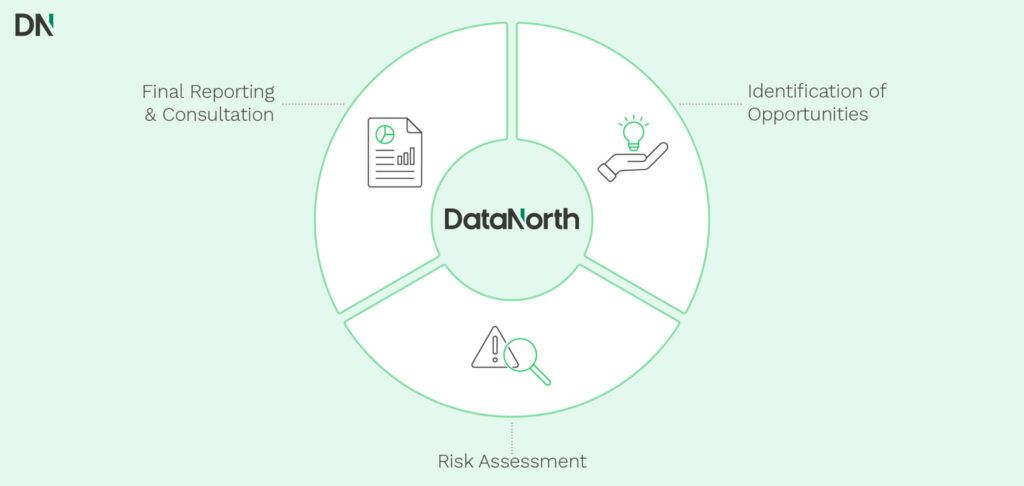
Don’t hesitate to contact one of our experts to find out how ChatGPT can help your business thrive in today’s digital landscape.


